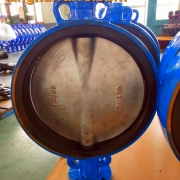Installation Position and Function of Marine Butterfly Valves on Ships
A marine butterfly valve is a common type of ship valve, widely used in various piping systems onboard. Below are its installation positions and functions on a ship:
Installation Positions of Marine Butterfly Valves
Butterfly valves are mainly used in locations where the pipe diameter is large, quick opening/closing is required, and installation space is limited. They are commonly found in the following piping systems:
Ballast Water System
Installed on ballast water pipelines to control the intake, discharge, and distribution of ballast water between tanks.
For example, on ballast water mains, branch lines, and at tank inlets/outlets.
Bilge (Seawater/Wastewater) System
Installed in bilge suction and discharge systems to control the drainage of seawater or wastewater.
Cooling Water System
Installed in the seawater cooling circuits of the main engine and generators to open/close or regulate the flow of cooling water.
Firefighting System
Installed on the main and branch fire mains to enable quick opening and closing of firefighting water supply.
Ventilation/Compressed Air Pipelines
Some butterfly valves are also used in non-liquid media pipelines, such as compressed air or low-pressure gas.
In general, butterfly valves are installed horizontally or vertically on pipelines, close to the area requiring control, for easy operation.
Functions of Marine Butterfly Valves
The primary functions are shut-off and throttling. Key characteristics include compact structure, light weight, easy operation, and low fluid resistance. Specific functions are as follows:
Shut-off or Open the Flow
Quickly cut off or open the water (or gas) flow in the pipeline.
Regulate Flow
Capable of adjusting the flow to some extent, not limited to fully open or fully closed positions.
Prevent Backflow
In combination with pipeline design, it helps prevent backflow (note: the butterfly valve itself does not have a check function; a check valve is required for that purpose).
Save Space and Weight
Compared to gate valves and ball valves, butterfly valves are lighter and more suitable for the limited space onboard ships.
Why are butterfly valves preferred on ships?
More economical and practical than gate or ball valves on large-diameter pipelines.
Lightweight, low operating torque, and quick to open/close.
Resistant to seawater, freshwater, oil, and other corrosive media (commonly made of stainless steel, bronze, or with rubber sealing materials).
Marine butterfly valves are typically installed on the main and branch lines of various shipboard water systems to control and regulate the flow of liquids or gases. Due to their light weight, simple structure, and easy operation, they are widely used in marine engineering and are an indispensable valve type in modern ship piping systems.

 tanghaivalve.com
tanghaivalve.com

 © Copyright 2020 Tianjin Tanghaidongyang Valve Co., Ltd. All Rights Reserved.
© Copyright 2020 Tianjin Tanghaidongyang Valve Co., Ltd. All Rights Reserved.